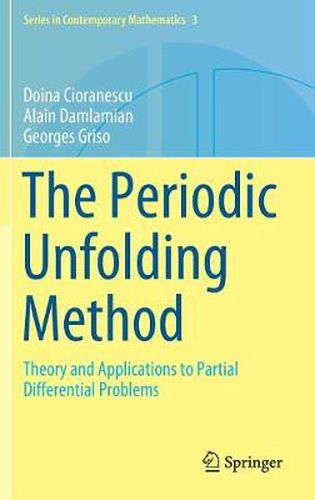Readings Newsletter
Become a Readings Member to make your shopping experience even easier.
Sign in or sign up for free!
You’re not far away from qualifying for FREE standard shipping within Australia
You’ve qualified for FREE standard shipping within Australia
The cart is loading…






This title is printed to order. This book may have been self-published. If so, we cannot guarantee the quality of the content. In the main most books will have gone through the editing process however some may not. We therefore suggest that you be aware of this before ordering this book. If in doubt check either the author or publisher’s details as we are unable to accept any returns unless they are faulty. Please contact us if you have any questions.
This is the first book on the subject of the periodic unfolding method (originally called eclatement periodique in French), which was originally developed to clarify and simplify many questions arising in the homogenization of PDE’s. It has since led to the solution of some open problems.
Written by the three mathematicians who developed the method, the book presents both the theory as well as numerous examples of applications for partial differential problems with rapidly oscillating coefficients: in fixed domains (Part I), in periodically perforated domains (Part II), and in domains with small holes generating a strange term (Part IV). The method applies to the case of multiple microscopic scales (with finitely many distinct scales) which is connected to partial unfolding (also useful for evolution problems). This is discussed in the framework of oscillating boundaries (Part III). A detailed example of its application to linear elasticity is presented in the case of thin elastic plates (Part V). Lastly, a complete determination of correctors for the model problem in Part I is obtained (Part VI).
This book can be used as a graduate textbook to introduce the theory of homogenization of partial differential problems, and is also a must for researchers interested in this field.
$9.00 standard shipping within Australia
FREE standard shipping within Australia for orders over $100.00
Express & International shipping calculated at checkout
This title is printed to order. This book may have been self-published. If so, we cannot guarantee the quality of the content. In the main most books will have gone through the editing process however some may not. We therefore suggest that you be aware of this before ordering this book. If in doubt check either the author or publisher’s details as we are unable to accept any returns unless they are faulty. Please contact us if you have any questions.
This is the first book on the subject of the periodic unfolding method (originally called eclatement periodique in French), which was originally developed to clarify and simplify many questions arising in the homogenization of PDE’s. It has since led to the solution of some open problems.
Written by the three mathematicians who developed the method, the book presents both the theory as well as numerous examples of applications for partial differential problems with rapidly oscillating coefficients: in fixed domains (Part I), in periodically perforated domains (Part II), and in domains with small holes generating a strange term (Part IV). The method applies to the case of multiple microscopic scales (with finitely many distinct scales) which is connected to partial unfolding (also useful for evolution problems). This is discussed in the framework of oscillating boundaries (Part III). A detailed example of its application to linear elasticity is presented in the case of thin elastic plates (Part V). Lastly, a complete determination of correctors for the model problem in Part I is obtained (Part VI).
This book can be used as a graduate textbook to introduce the theory of homogenization of partial differential problems, and is also a must for researchers interested in this field.